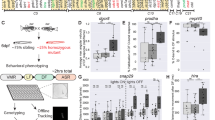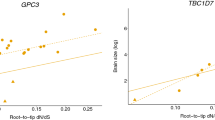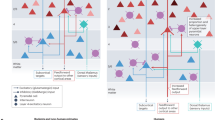Abstract
One of the most notable trends in mammalian evolution is the massive increase in size of the cerebral cortex, especially in primates. Humans with autosomal recessive primary microcephaly (MCPH) show a small but otherwise grossly normal cerebral cortex associated with mild to moderate mental retardation1,2,3,4. Genes linked to this condition offer potential insights into the development and evolution of the cerebral cortex. Here we show that the most common cause of MCPH is homozygous mutation of ASPM, the human ortholog of the Drosophila melanogaster abnormal spindle gene (asp)5, which is essential for normal mitotic spindle function in embryonic neuroblasts6. The mouse gene Aspm is expressed specifically in the primary sites of prenatal cerebral cortical neurogenesis. Notably, the predicted ASPM proteins encode systematically larger numbers of repeated 'IQ' domains between flies, mice and humans, with the predominant difference between Aspm and ASPM being a single large insertion coding for IQ domains. Our results and evolutionary considerations suggest that brain size is controlled in part through modulation of mitotic spindle activity in neuronal progenitor cells.
This is a preview of subscription content, access via your institution
Access options
Subscribe to this journal
Receive 12 print issues and online access
$209.00 per year
only $17.42 per issue
Buy this article
- Purchase on SpringerLink
- Instant access to full article PDF
Prices may be subject to local taxes which are calculated during checkout





Similar content being viewed by others
References
Aicardi, J. Diseases of the Nervous System in Childhood edn 2, 90–91 (MacKeith, London, 1998).
Pattison, L. et al. A fifth locus for primary autosomal recessive microcephaly maps to chromosome 1q31. Am. J. Hum. Genet. 67, 1578–1580 (2000).
Jamieson, C.R., Fryns, J.P., Jacobs, J., Matthijs, G. & Abramowicz, M.J. Primary autosomal recessive microcephaly: MCPH5 maps to 1q25–q32. Am. J. Hum. Genet. 67, 1575–1577 (2000).
Bundey, S. in Emery and Rimoin's Principles and Practice of Medical Genetics 3rd edn (eds Rimoin, D.L., Connor, J.M. & Pyeritz, R.E.) 730–731 (Churchill Livingstone, New York, 1997).
Ripoll, P., Pimpinelli, S., Valdivia, M.M. & Avila, J. A cell division mutant of Drosophila with a functionally abnormal spindle. Cell 41, 907–912 (1985).
Gonzalez, C. et al. Mutations at the asp locus of Drosophila lead to multiple free centrosomes in syncytial embryos, but restrict centrosome duplication in larval neuroblasts. J. Cell Sci. 96, 605–616 (1990).
Mochida, G.H. & Walsh, C.A. Molecular genetics of human microcephaly. Curr. Opin. Neurol. 14, 151–156 (2001).
Jackson, A.P. et al. Primary autosomal recessive microcephaly (MCPH1) maps to chromosome 8p22–pter. Am. J. Hum. Genet. 63, 541–546 (1998).
Roberts, E. et al. The second locus for autosomal recessive primary microcephaly (MCPH2) maps to chromosome 19q13.1–13.2. Eur. J. Hum. Genet. 7, 815–820 (1999).
Moynihan, L. et al. A third novel locus for primary autosomal recessive microcephaly maps to chromosome 9q34. Am. J. Hum. Genet. 66, 724–727 (2000).
Jamieson, C.R., Govaerts, C. & Abramowicz, M.J. Primary autosomal recessive microcephaly: homozygosity mapping of MCPH4 to chromosome 15. Am. J. Hum. Genet. 65, 1465–1469 (1999).
Roberts, E. et al. Autosomal recessive primary microcephaly: an analysis of locus heterogeneity and phentoypic variation. J. Med. Genet. (in press) (2002).
Peltonen, L., Jalanko, A. & Varilo, T. Molecular genetics of the Finnish disease heritage. Hum. Mol. Genet. 8, 1913–1923 (1999).
den Hollander, A.I. et al. Mutations in a human homologue of Drosophila crumbs cause retinitis pigmentosa (RP12). Nature Genet. 23, 217–221 (1999).
Saunders, R.D., Avides, M.C., Howard, T., Gonzalez, C. & Glover, D.M. The Drosophila gene abnormal spindle encodes a novel microtubule-associated protein that associates with the polar regions of the mitotic spindle. J. Cell Biol. 137, 881–890 (1997).
Craig, R. & Norbury, C. The novel murine calmodulin-binding protein Sha1 disrupts mitotic spindle and replication checkpoint functions in fission yeast. J. Cell Sci. 11, 3609–3619 (1998).
Embryonic vertebrate central nervous system: revised terminology. The Boulder Committee. Anat. Rec. 166, 257–262 (1970).
Anderson, S.A., Eisenstat, D.D., Shi, L. & Rubenstein, J.L. Interneuron migration from basal forebrain to neocortex: dependence on Dlx genes. Science 278, 474–476 (1997).
Wichterle, H., Garcia-Verdugo, J.M., Herrera, D.G. & Alvarez-Buylla, A. Young neurons from medial ganglionic eminence disperse in adult and embryonic brain. Nature Neurosci. 2, 461–466 (1999).
Seri, B., Garcia-Verdugo, J.M., McEwen, B.S. & Alvarez-Buylla, A. Astrocytes give rise to new neurons in the adult mammalian hippocampus. J. Neurosci. 21, 7153–7160 (2001).
Gould, E., Tanapat, P., Rydel, T. & Hastings, N. Regulation of hippocampal neurogenesis in adulthood. Biol. Psychiatry 48, 715–720 (2000).
Doetsch, F. & Alvarez-Buylla, A. Network of tangential pathways for neuronal migration in adult mammalian brain. Proc. Natl Acad. Sci. USA 93, 14895–14900 (1996).
do Carmo Avides, M., Tavares, A. & Glover, D.M. Polo kinase and Asp are needed to promote the mitotic organizing activity of centrosomes. Nature Cell Biol. 3, 421–424 (2001).
Wakefield, J.G., Bonaccorsi, S. & Gatti, M. The Drosophila protein asp is involved in microtubule organization during spindle formation and cytokinesis. J. Cell Biol. 153, 637–648 (2001).
Rakic, P. Neuronal migration and contact guidance in the primate telencephalon. Postgrad. Med. J. 54, 25–40 (1978).
Takahashi, T., Nowakowski, R. and Caviness, V.S. Jr. The cell cycle of the pseudostratified ventricular epithelium of the murine cerebral wall. J. Neurosci. 15, 6046–6057 (1995).
Roegiers, F., Younger-Shepherd, S., Jan, L.Y. & Jan, Y.N. Two types of asymmetric divisions in the Drosophila sensory organ precursor cell lineage. Nature Cell Biol. 3, 58–67 (2001).
Lu, B., Jan, L. & Jan, Y.N. Control of cell divisions in the nervous system: symmetry and asymmetry. Annu. Rev. Neurosci. 23, 531–556 (2000).
Chenn, A. & McConnell, S.K. Cleavage orientation and the asymmetric inheritance of Notch1 immunoreactivity in mammalian neurogenesis. Cell 82, 631–642 (1995).
Bienz, M. Spindles cotton on to junctions, APC and EB1. Nature Cell Biol. 3, E67–E69 (2001).
Acknowledgements
E.R., K.S., S.S. and C.G.W. are supported by The Wellcome Trust Research Leave Fellowship for Clinical Academics; J.B. and D.J.H. were supported by the West Riding Medical Research Trust Fund of the University of Leeds; G.H.M. is a Howard Hughes Medical Institute Physician post-doctoral fellow; and C.A.W. is supported by US National Institute of Neurological Disorders and Stroke and the March of Dimes. We thank U. Berger for help with the in situ hybridization; K.S. Krishnamoorthy, P.E. Grant and J.A.Guthrie for help with MRI images; and R.S. Hill for help with electronic analysis of candidate genes.
Author information
Authors and Affiliations
Corresponding author
Ethics declarations
Competing interests
The authors declare no competing financial interests.
Rights and permissions
About this article
Cite this article
Bond, J., Roberts, E., Mochida, G. et al. ASPM is a major determinant of cerebral cortical size. Nat Genet 32, 316–320 (2002). https://doi.org/10.1038/ng995
Received:
Accepted:
Published:
Issue Date:
DOI: https://doi.org/10.1038/ng995
This article is cited by
-
Investigating the effects of a single ASPM variant (c.8508_8509) on brain architecture among siblings in a consanguineous Pakistani family
Molecular Biology Reports (2024)
-
Targeting TRIP13 in favorable histology Wilms tumor with nuclear export inhibitors synergizes with doxorubicin
Communications Biology (2024)
-
Advances and Applications of Brain Organoids
Neuroscience Bulletin (2023)
-
How mechanisms of stem cell polarity shape the human cerebral cortex
Nature Reviews Neuroscience (2022)
-
Equivocal evidence for a link between megalencephaly-related genes and primate brain size evolution
Scientific Reports (2022)



